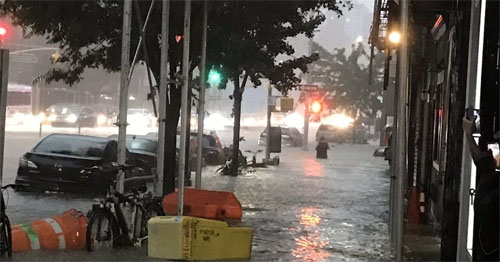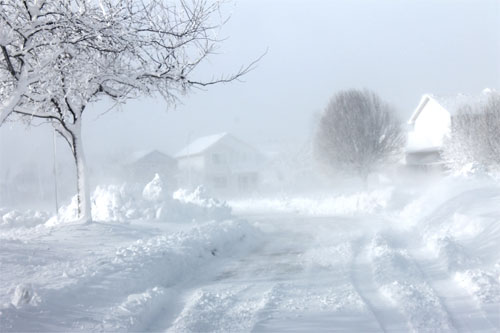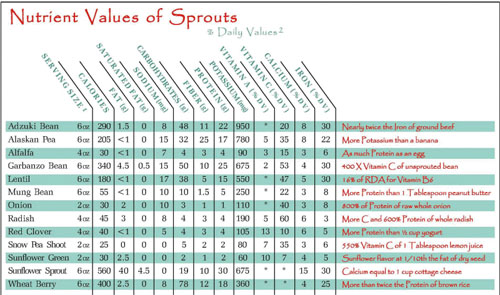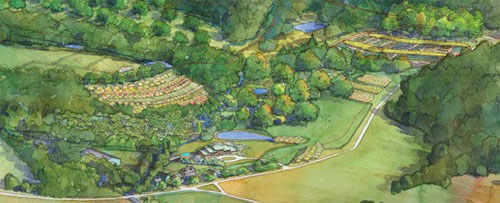
Green streets policies support attractive design for walkways and neighborhoods, such as this curb cut walkway along Scott Avenue in Tucson. Photo credit: Wheat Design Group.
Russian Olga Sokolskaya says: “Rain gardens” are another topical element in shaping the environment. It is a stormwater management system. Good examples include green roofs, permeable sidewalk, rainwater harvesting [curb cuts included], green streets, storm parks. These rain gardens effectively discourage storm water pollution and reduce the likelihood of flooding, create open spaces for relaxation and living, improve air quality, regulate the climate and, of course, provide us with another attractive green solution. See more of her perspectives… A practical point to consider is that a study in Seattle found that homes on streets with rain gardens were worth 3.5-5 % more than homes on other streets…and they are pretty.
I live in a hilly arid area, Santa Barbara County, CA. Rain is predicted as I write this and I think, again, how much water is lost to runoff. I think how we need to start with properties in higher areas to reduce flooding below. I especially think of the slow, spread, sink factors, emphasis on SPREAD, rather than water channeled down streets, bypassing trees that so desperately need it. During the recent long years of drought, Santa Barbara County was the last red zone, the driest in the state.
Every inch of rainfall, on a 10-foot wide paved street – that’s a very narrow street – will drain 27,800 gallons of rainfall per mile. And that’s not on a slope or steep street! That’s a lot of water we could use. 1″ of rain equals .623 gallon per square foot! How many square feet is your roof, your sidewalk? Cities are now taking responsibility for this incredibly useful and important green infrastructure.
Curb cuts can be at your home, along a driveway, the parkway along your road, medians, in commercial areas, in parking lots, your local park! Slow, Spread, Sink are the bywords! First we divert the water into an eddy basin and slow it. The basin allows the water to a spread, then sink so more water can enter and sink. When it is full it is self regulating – the water merely keeps flowing by since there is no lower area for it to go. Flooding and its damage may be avoided.
There are good reasons for Curb cuts! Water harvesting is Number One in drought areas and water spreading in flood areas. The higher in the area they are located, the more they slow runoff, reduce stormwater runoff damage and flooding in lower areas. There is less erosion, loss of precious topsoil. They reduce homeowner watering costs, gives greywater to our trees, sometimes lawns and veg gardens. The water held improves our soil and in time water retention is dramatically improved, as is our water table level! Run-off is filtered before it enters the ground, and at lakes and by streams and oceans, the water is filtered of pollutants before it enters the water. Animals are saved, fish and food sources are renewed. These lovely places can provide habitats beneficial for wildlife, flowers for pollinators!
Why curb cuts?! DIY basic curb cuts are simple and inexpensive to do. No parts are needed. In many cases no permits are needed. They are just a differently intentioned rain garden, built slightly differently! The cut itself can be quite variable per the place it will be used. There can be one or many cuts. They can be big or small, angled for best water capture, on slopes or flat land. You will need a shovel, someone to make the cuts and the gear to do it, very likely some cobble, and if you plant it, the cost of the plants, maybe some mulch. If terracing along a slope, consult with your civil engineer. If feasible, you will likely need big cobble and/or larger stones or weirs, even a series of weirs.
One author says: …I would like to say that a rain garden is an effective bioengineering solution to the problem of flooding areas, as well as purification of polluted rain streams. Rain gardens cannot completely replace the drainage system, they complement and improve it, ensuring stable operation. In addition to fulfilling their main functions, rain gardens also have an aesthetic component – they are wonderful elements for decorating cottages, walking paths in parks, city streets, roads and public buildings.
Water saving systems can be done many ways! Rain Gardens, small, large, or along a roadside, are lovely. Bioswales can be part of systems diverting water to areas that need it, or to large holding areas where water can be allowed to spread and sink. Put rough big materials in the bottom to slow that water down so it has time to sink. Cleverly make that bioswale curvy – install ‘S’ curves, to slow that water down! Make side branches, bulges along the way, and deltas to spread that water. Make generous stormwater retention ponds along the way. Storm control with permeable pavers and giant underground reservoirs are phenomenal and best for heavy vehicles.
Residents can make their own variations of curb cuts in the form of mini bioswales. Larger stones slow water, can act as bridges or water holding areas. On left, a dry creek rain swale in a suburban garden landscape. By Alicia Springer


If you want to do your own curb cuts, there are myriad guides online. First, check your local laws. Some cities are doing and trialing curb cut systems and you can suggest locations. Look into credits given toward clean water treatment control you may consider doing. In Santa Barbara area, please see pages 4-10 of Santa Barbara County Green Infrastructure for Storm Water Runoff Slopes are a challenge and consulting a civil engineer, a professional, is suggested.
When you get down to the work of it, pay attention to your soil substrate – is is rock solid clay? Might pass on that area. Think about slope, parking hazards, trees, pedestrian safety, contamination that may be brought in, archeological concerns. You don’t want to make a muddy area that collapses from the weight. Don’t forget, sidewalk runoff can be captured too!
Here is one diagram of a City of Claremont curb cut plan. The area is dug down below the surrounding area. The basin is prepared as needed per what is wanted to be achieved. Water flows in, the area fills. When it is full, no more water goes in, it just keeps flowing by, not finding a lower entry point. The curb cuts can be angled to capture the incoming water per the direction it comes from. The size of the cut and the number of cuts determine how much water is allowed in. On a slope image I have seen 1″ cuts that really slowed the water’s entry speed and the amount possible to go in.

Here’s another version planted with trees! Bioswale concept diagram: (1) Dirty and polluted water from rooftops, roads and parking lots enters the bioswale; (2) Water is slowed down by various plants and rocks, pollutants settle out, clean water infiltrates the soil; (3) Water enters the perforated pipe and is slowly absorbed into the ground; (4) Excess stormwater exits the bioswale and flows through the pipe into the recipient, cleaner than when it entered and in the amount significantly reduced.

Slopes require different design! Deeper water holding areas, strong basin dividers, sometimes bank support. Weirs with notches for spillways, pipes, more. There are so many lovely ways to treat them! The image at right shows Curb Cuts on a Sloped Street using water holding terracing. Moreland, Victoria, Australia


Please see some terrific examples here of sloped areas that Arlington VA calls ‘Green Streets.’ They say ‘A green street is a street with a vegetated area in the public right of way that reduces the volume of stormwater and stormwater pollutants that enter our local streams, Potomac River and the Chesapeake Bay. They are one of the best tools we have at our disposal to address environmental and regulatory stormwater needs.’
Be creative with your curb cuts and inlets! Make them as long as you want. Shape them for easy access for the water. Pay special attention to the direction the water is coming from to angle the cuts to capture it. Make wings, image 4, to protect the bank of the basin from eroding as the water enters. If one cut isn’t enough, add another one or make it longer!

The City of Burnsville MN is making beauty and harvesting water!






Plants play a crucial part. Plants need to be both water and dry tolerant, whether flowers or serious working plants! Deluge and drought areas, established deep rooted native plants can hold their own on sloped street parkways to slow water. Bebas Banjir says: ‘Native plants don’t require fertilizer, have good root systems, and are better at utilizing the water and nutrients available in their native soils than non-native species.’ He has a lot more to say! An experienced installer says stay away from invasives. Plants are generally planted on the slopes, sides, of basins and in the cracks between groups of rocks, not on the flat bottom.
Trees! If you are doing a rain garden, you don’t want trees that suck up the water. If you have trees that need water, be sure to make your area big enough to help the trees and use underground storage devices that gradually release the stored water to your trees. Some say, forget the storage devices, Soil is the best place to store rainwater! Do what you feel is the long term best! If you are in a flood zone, plant thirsty trees that don’t mind water and to take up that water!
However, depending on the specific purpose of a rain garden, the design may vary, and interesting additional functions may also be added. In some rain gardens there is a function of a reserve (reserve) of water – first, water is purified by passing through terraces from plants, then it enters an underground reservoir. The water is stored there and will be used for underground irrigation of trees during dry weather. There are also rain gardens designed to protect areas from flooding during storms.
Working Plants If in arid or short rain season areas, or your water flows to the ocean, your first consideration is plants that detox the water and soil. This is especially true in urban areas with water coming off the street. That would be special detoxing grasses and plants that filter the water and help with soil remediation, chemicals from street runoff. After a flood, install ground covers of water absorbing plants to detox the soil if you must replant in areas that have flooded. Plant quick growing legume plants and legume trees to feed and restore the soil. Include both native water and drought tolerating plants that will grow deep and break up that soil, that make breathing airways for soil organisms that will help clean up the soil. Check out Phoenix AZ suburb Avondale AZ diagrams, plans for several situations including plants, and, fabulous plants lists! In fact, Cities who have been water harvesting many years, 20, 30, often include plant lists for residents in their city water management plan PDFs! Choose one or two that best represent your area.
If you want beauty for your pollinators, food for birds, plant a mixture of water loving/drought tolerant flowers, herbs, perennials, and shrubs, for all seasons habitat.
RESIDENTIAL

This area between the sidewalk and the road has many names. Depending on where you live, it’s called a boulevard, median, hellstrip, parkway, verge or tree belt. This spot has been dug down for water collection and the vigorous growth of the planting shows the lovely result! Here’s a nifty little quicky Introduction to Rain Gardens from Cornell!
 Green street terracing at the sloped John Marshall Drive, median as part of a storm sewer improvement project in the area. Arlington VA
Green street terracing at the sloped John Marshall Drive, median as part of a storm sewer improvement project in the area. Arlington VA
What if your street doesn’t have a curb?! All the easier! You don’t have to make a curb cut because the street slope can bring the water right where you want it! How about a rain garden type ‘eddy basin?!’ This one is super simple to do, brings beauty to your home, reduces water costs.

Maplewood, MN streetside Rain Garden
Calculations are important! Design for an adequate capture area wherever you are harvesting water! This helps restore our water table. Thanks to Surfrider.org for this image. The Surfrider Foundation is a super conscientious environmental organization. You can see how important this is to them. We want those dolphins and our surfers to have safe clean water.

What fine Marin CA Green Street Planters! Sidewalk slope and curb cuts, plus allowance for offloading area from parked vehicles and walkways to sidewalk, make all the difference! Small Design, Big Impacts!

Aesthetic curb cut grates designed for safe walking for pedestrians and people off loading from vehicles. Parkways become filled with inspiring healthy vigorous plants. This image is posted on the Stormwater Management Handbook of Northern Kentucky Communities. Plenty of useful ideas and details here! Photo by Kevin Robert Perry, City of Portland


Before the work, road runoff would flow up against and flood the house. After the work, the dirt dug from the street-side basins created a raised walkway that acts as a berm ensuring no basin water or street runoff can flow up against the house. Before the work, there was no walkway; now there is a wonderful path wide enough for two people to walk side by side, separated by the trees from cars and street. Now the trees have grown to shade both walkway and street.
Author, Zhehang Li says, ‘Sometimes, the smallest design can make great impacts.‘
ALONG ROADWAYS – MEDIANS, are super bioretention areas!
Biofiltration! For roadway plantings, hyperaccumulator plants are important. A hyperaccumulator is a plant that capable of growing in soil or water with very high concentrations of metals, absorbing these metals through their roots, and concentrating extremely high levels of metals in their tissues. Find out which ones grow in your area. They are capable of phytoremediation, a bioremediation process that uses various types of plants to remove, transfer, stabilize, and/or destroy contaminants in the soil and groundwater. FIVE best plants! Here you see cobble stones slowing water, protecting the integrity of the edge of the basin and plants at the water entry point. All the beautiful trees here are well watered and flourishing!

COMMERCIAL and PARKING AREAS – GREATER URBAN RESILIENCE! You might see the letters LID used, Low Impact Development.
Proper design is key as maintenance is not the same as typical landscaping. Rain is one thing, clean, while run on water brings sediment. Sediment clogs the pores in soil. In some city systems, that fine sediment, called fines, is simply vacuumed! Know that your Curb Cut eddy basin will need maintenance. Some cities have two person teams to make sure cuts and flow ways are clear before a rain. Depending on your situation, many clear debris/sediment after each storm; in a big storm the soil can be quickly overwhelmed. Other basins need clearing only once a year, very low maintenance! The basin itself may fill with sediment and need a dig out clearing. Gravel fills with sediment and is heavy to work with to clean. It may be more simple to replace it, a cost. Some do plantings in their deep basin areas. Mulch is cheap and keeps weeds down, needs occasional replacement. Over years, it remarkably improves the water holding capacity of the soil. If you plant your eddy basin, it will need supplemental irrigation until your plants are established.
Sediment prevention can be helped by installing a pre barrier like a small cobble filled trench, a permeable netting staked vertically along an edgeway. However, some recommend to never use filter fabric because it in turn adds synthetics to the landscape that block the water from percolating into the water table and the soil from building biology. Landscape fabrics are usually synthetic, made from polyester or polypropylene.
Large pretreatment catch basins can be made. ‘Bottomless’ have large ungrouted boulders that allow water to infiltrate. Concrete is not porous. Neither Porous concrete or porous asphalt can be cleaned and the asphalt is toxic. 8-10″ Cobble may be your answer. There is more air and no standing water for mosquitos.
The image on the left shows both curb and sidewalk cuts to allow rainwater entry. The right shows a terracing weir and attractive pedestrian protection for the basin with plantings including flowers! It’s an image used in the State College of Pennsylvania Mansfield Rising Plan.


Parking lots are often massive land use areas that receive huge amounts of water!

Thinking has really changed. Parking lots are now being built with land included for water harvesting and cleaning. The area is sloped toward the plants that filter the water. Some have curb cuts or no curbs at all so the water can enter freely. Sidewalks, parking areas, and streets are now being built sloped toward water capture areas. The parking lot below is a lovely mature water harvesting area. Thanks to McKenney’s Inc. in Atlanta, GA

PARKS!
The Edinburgh Gardens Rain Garden in Melbourne, Australia is stunning! Melbourne experienced some years of drought and this extensive project was to replace the existing need for potable water being used to irrigate the parks and gardens. It provides treated irrigation rainwater for surrounding trees and other vegetation and sports venues. The construction of the rainwater park solves the double crisis of local drinking water and irrigation water. Various water landscapes and corresponding measures in the park collect and store rainwater, purify the water body and distribute it to the required area through the shunt pipe. The water source is purified by the natural action of filter media and various vegetation. Collection areas prevent spreading of pollution. The four platforms in the park are convenient for visitors to enjoy the beautiful scenery and engage in outdoor sports. According to some reports, rain gardens can reduce the amount of polluting flows by 25-40%. This is the Chalvey Brook Character Area. See some of the structural details.

This is not a curb cut collection type area, but you can see how water is channeled into the bioswale, large boulders and cobble, plus curves, slow the water. Beautiful Nature Walk Bioswale at Dawn, Duarte CA by BlueGreen Consulting. See more at Veg Gardening Changing Climate Survival Guide!

Saturday, Sept. 29, 2012, the Ventura Ocean Friendly Gardens team returned to the recently completed garden to take it one step further: the first residential ‘curb cut’ in Ventura CA! At that time it was stated: In order to make this possible, the City of Ventura will soon be offering a standard design, no-cost permit for all City residents, a first in the nation!
Research pointer. Universities are much smaller than large cities that have many kinds of streets and circumstances. Universities will do research projects, students do papers, cooperative extension tries to serve the community and often includes Master Gardener programs. Sometimes they sport the cutting edge and come up with super innovative options, often starting a whole new way of doing things. Cities have all kinds of buildings, highways, urban/residential to rural. They have broad challenges and a lot of experience in practical applications. Much of what their management programs and PDFs show are well proven. If you have some tough questions, consult with their experts per your unique situation. Get around and get a few different opinions.
All over the world people are wanting water, clean water. Do what YOU can do. You may or may not enjoy gardening, or be able to maintain a curbside water gathering space. The simplest is to have someone do the curb cut for you, then, if you are on a slope, dig your basin, have 8-10″ cobble hauled in and forget it. If your land is level, get the curb cut, have someone dig and put the plants and mulch in, with cobbles at the entry point to slow the entry of the water. If you can, hire a maintenance landscaper to care for it. If they are educated about water/drought plants, and plants that detox and feed the soil, all the better.
Here is a 2018 delightful tale by Urban Planner Dan Read. He tells what happened in Wheaton Woods, a Washington DC, Montgomery County area, when the powers that be intended to install rain gardens. It’s funny and becomes inspiring, along with some practical pithy and informative comments following! Worth the read. Montgomery residents are fighting plans to build rain gardens
Next time, take a walk in the rain…to find spots that could be more beautiful and profit from a Curb Cut. Do your curb cuts and eddy basins well before your rainy season or as soon as you can. If you will be planting, do your plant installation as early as possible so their roots will be well established and ready to do their job.
Small changes add up! Preserve your precious water!
In honor of Barbara Wishingrad, Sweetwater Collaborative, Santa Barbara CA, for all her dedicated work.
Updated 3.10.21
Love your Mother! Plant bird & bee food! Think grey water! Grow organic! Bless you for being such a wonderful Earth Steward!
The Green Bean Connection started as correspondence for the Santa Barbara CA USA Pilgrim Terrace Community Garden. Both of Santa Barbara City’s remaining community gardens are very coastal. During late spring/summer we are often in a fog belt/marine layer most years, locally referred to as the May grays, June glooms and August fogusts. In 2018 they lasted into September and October! Keep that in mind compared to the microclimate niche where your veggie garden is.








